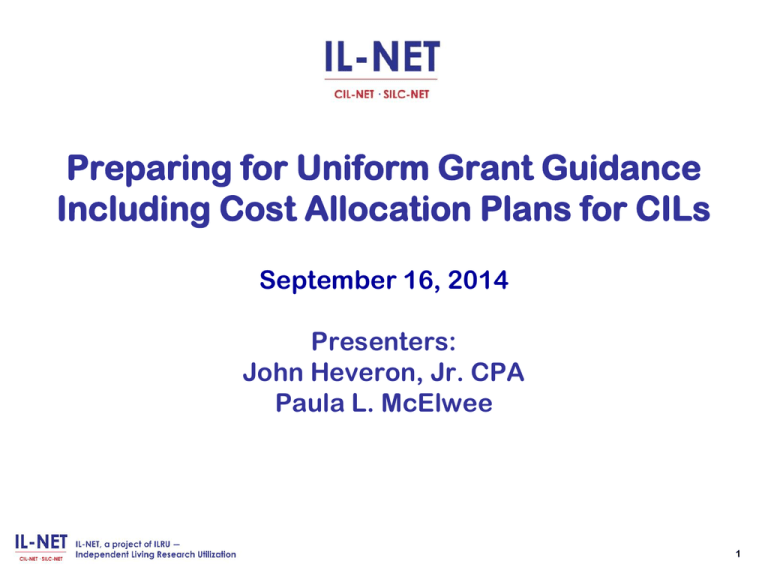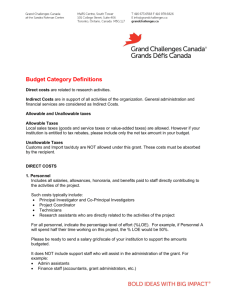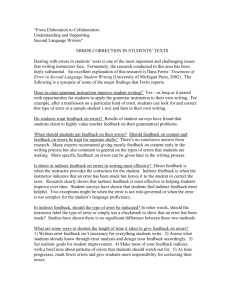What is a Cost Allocation Plan?
advertisement

Preparing for Uniform Grant Guidance Including Cost Allocation Plans for CILs September 16, 2014 Presenters: John Heveron, Jr. CPA Paula L. McElwee 1 Upon completion of this webinar, participants will be able to: • Define the purpose, objectives, and contents of a CIL Cost Allocation Plan. • Understand how soon-to-be-implemented Uniform Grant Guidance will affect cost allocation plans, indirect cost rates, and other requirements. • Identify the areas that are changing and the items that will require development and implementation of clear policies, procedures, and monitoring controls. • Identify the role of senior management in successful implementation of the guidelines, which become effective for non-profits on December 26, 2014. 2 Uniform Grant Guidance: What You Need to Know Now • Uniform Grant Guidance is effective December 26, 2014 and will apply to any new federal grants and new federal awards starting after that time. • Every federal agency is rewriting their regulations. (Department of Education rewriting EDGAR, HHS rewriting HHS Regulations) • They will be very focused on these new rules. • We will be updating our sample policies and procedures and providing additional training as these changes become clear. 3 Uniform Grant Guidance: What You Need to Do Before Year-End • Get a more thorough understanding about uniform grant guidance, and how it applies to you based on your funding and your operations. The US chief Financial Officers’ Council provides links and training https://cfo.gov/cofar/ • Develop and adopt policies and procedures to comply with the new rules (Internal Controls, Procurement, Cost Allocation) • Identify who will be responsible for compliance with these rules. • Obtain training about the new rules for responsible individuals. • Stay tuned—we will be providing assistance in these areas. 4 How does this affect cost allocation? • Remember that every non-profit that receives federal funds must have a written, approved method for spreading indirect or shared costs across its projects. • Centers have most often used a cost allocation plan, although an approved Indirect Cost Rate is an option. • Cost Allocation Plans are approved by Department of Education’s Indirect Cost group. We will let you know when HHS assumes this for centers. • When HHS regulations are released we will have the detail needed to assist you in applying changes. 5 Uniform Grant Guidance: Direct and Indirect Costs • Appendix IV of Uniform Grant Guidance has information about indirect cost rates for nonprofits including the process for obtaining indirect cost rates. • Section 200.425 groups indirect cost rates with Cost Allocation Plans, so we believe the same rules will apply. 6 Questions and Answers 7 What is a Cost Allocation Plan? • A cost allocation plan is a written procedure charging direct and indirect costs to programs and other functions. • Direct costs are those that can be identified specifically with a particular cost objective (one of your programs or other activities such as fundraising). • Indirect costs benefit all programs and must be shared or split fairly between those programs. • A simplified allocation method is available to many small organizations including most CILs. It allows these organizations to treat everything as direct except “general administrative and general expenses” (in other words, general administrative and general is the same as indirect). 8 What is a Cost Allocation Plan? cont’d. • General administrative and general expenses include costs such as receptionist, accounting, rent and utilities for your business office and similar items that benefit all programs. • Agencies that don’t have current approved indirect cost or cost allocation plans , and don’t elect the 10% reimbursement may be denied any indirect cost reimbursement. • While this is NOT a revenue allocation plan, most States and RSA are requiring that you separate out your costs by funding source or grant rather than the more general “cost objective.” 9 Cost Allocation Plan Example We are going to work through a sample cost allocation plan based on the typical programs you may have. 10 This is a sample plan and sample language • You can use some of the following language to develop your cost allocation plan but you will need to change the titles and content to very specifically describe your CIL and your allocation procedures. • Key staff need to understand this plan and continue to apply it correctly over time, not just once. • If something in your formula changes, you need to adjust accordingly. One center that used square footage as part of the formula, moved to another building but forgot to adjust their allocation. As a result they had a payback to RSA. 11 Contents: Cost Allocation Plan Application for our hypothetical CIL—PENN CIL Cost Allocation Procedures—Attachment A Organization Chart—Attachment B Schedule of Federal Awards—Attachment C Schedule of Direct and Indirect Costs—Attachment D Schedule of Payroll and Related Costs—Attachment E Certification of Cost Allocation Plan—Attachment F Reconciliation to form 990, Financial Statements, or approved budget—Attachment G • Timesheet Example—Attachment H • Contact information—name, address, phone, email • • • • • • • 12 Attachment A—Cost Allocation Policy/ Procedures (example) Open with a Purpose/General Statement: The purpose of this cost allocation Policy is to summarize the methods and procedures that this organization uses to charge direct costs and to allocate indirect costs to various programs, activities, grants, contracts and agreements. 13 Purpose/General Statements, cont’d. 2 l Only costs that are allowable, in accordance with the Uniform Grant Guidance, are to be charged to programs by PENN CIL, Inc. We have eliminated items that would cause distortion such as certain contracts that pass along benefits directly to consumers but do not impact indirect costs. 14 Questions and Answers 15 General Approach (example) PENN CIL follows US generally accepted accounting principles and uses the accrual basis of accounting. The general approach of PENN CIL in allocating costs to particular grants and contracts is as follows: A. All allowable direct costs are charged directly to programs, grants, activities, etc. B. If an allowable direct cost can be identified to more than one program (such as the time for a specific staff person) it is pro-rated as direct cost using a base most appropriate to the particular cost being prorated (in the case of staff time, the time and effort reporting). 16 General Approach, cont’d. C. All other allowable general and administrative costs (costs that benefit all programs and cannot be identified to a specific program) are pooled and allocated to programs, grants, etc. based on the ratio of direct costs for each program or activity to total direct costs (or based on the ratio of direct salaries for each program or activity to total direct salaries.) 17 Allocation of Costs (example) The following information summarizes the procedures used by PENN CIL, Inc. beginning October 1, 2014. A. Payroll and Related Costs—Documented with timesheets and personnel activity reports (PARs) showing time distribution for all employees and assigned to programs and activities based on time spent on each program, activity or grant. Salaries and wages are charged directly to the program for which services have been performed. Costs that benefit all programs are allocated based on the ratio of direct costs for each program or activity to direct costs. 18 Allocation of Costs, cont’d. A. Payroll and Related costs cont’d. 1. Fringe benefits (FICA, Unemployment Compensation, and Worker’s Compensation) are assigned in the same manner as salaries and wages. Health insurance, dental insurance, life and disability, and other fringe benefits are also allocated in the same manner as salaries and wages. 2. Vacation, holiday, and sick pay are assigned in the same manner as salaries and wages. 19 Examples of Salary Costs Included as Indirect Costs and Supported by Detailed Records • Executive Director’s time/salary and fringe costs may be both direct and indirect. Direct costs are shared between all the grants/programs based on actual time records. • A Program Manager’s time/salary and fringe costs are shared between all the grants/programs based on actual time records. • General and indirect salaries such as the receptionist, the accounting staff, some Executive Director salary and fund developer may be generally indirect and included in the overall indirect costs. 20 Allocation of Costs, cont’d. 2 B. Travel Costs—assigned based on purpose of travel. All travel costs (local and out-of-town) are charged directly to the program for which travel was incurred. Costs that benefit all programs are included with general and administrative, and allocated based on the ratio of direct costs for each program or activity to total direct costs. 21 Allocation of Costs, cont’d. 3 C. Equipment—assigned based upon use. Equipment is capitalized and depreciated when the initial acquisition costs exceed $1,000 [or whatever capitalization amount you use], and the useful life of the equipment exceeds one year. Items below those limits are expensed in the current year. Equipment used solely by one program is charged directly to the program using the equipment. Costs that benefit all programs are included with general and administrative, and allocated based on the ratio of direct costs for each program or activity to total direct costs. 22 Allocation of Costs, cont’d. 4 D. Contracted Services Costs (such as consulting and interpreter services)—assigned to the program benefiting from the service. All professional service costs are charged directly to the program(s) for which the service was incurred. Costs that benefit all programs are included with general and administrative, and allocated based on the ratio of direct costs for each program or activity to total direct costs. 23 Examples of Contracted Service Costs • • • • • • Janitorial services/building maintenance Alarm services Accountant Interpreter services Audit Payroll services 24 Allocation of Costs, cont’d. 5 E. Rent and Utilities—assigned based on usable square footage. Facilities costs that benefit all programs are included with general and administrative, and allocated based on the ratio of direct costs for each program or activity to total direct costs. F. Office supplies and expenses—Expenses used for a specific program are charged directly to that program. Costs that benefit all programs are included with general and administrative, and allocated based on the ratio of direct costs for each program or activity to total direct costs. 25 Allocation of Costs, cont’d. 6 G. Supplies and Materials—Expenses used for a specific program are charged directly to that program. Costs that benefit all programs are included with general and administrative, and allocated based on the ratio of direct costs for each program or activity to total direct costs. H. Dues, Subscriptions, Postage and Printing—Expenses are charged directly to the program benefiting from them. Costs that benefit all programs are included with general and administrative, and allocated based on the ratio of direct costs for each program or activity to total direct costs. 26 Allocation of Costs, cont’d. 7 I. Training, Conferences, Seminars—Allocated to the program benefiting from these activities. Costs that benefit all programs are allocated as indirect. J. Administrative/Board Costs are allocated as indirect. K. Insurance—Expenses used for a specific program are charged directly to that program. Costs that benefit all programs are included with general and administrative, and allocated based on the ratio of direct costs for each program or activity to total direct costs. 27 Allocation of Costs, cont’d. 8 L. Other—Allowable costs that benefit a single or multiple programs are assigned directly to those programs. Costs that benefit all programs are included with general and administrative, and allocated based on the ratio of direct costs for each program or activity to total direct costs. 28 Examples of Costs that Typically Cannot Identify to a Particular Program • General bookkeeping and accounting • General liability insurance • Independent audit costs and costs of preparing annual filings 29 Allocation of Costs, cont’d. 9 M. Unallowable Costs—Costs that are unallowable with federal funds in accordance with the Uniform Grants Guidance, include alcoholic beverages, bad debts, certain advertising, contributions, certain entertainment, fines and penalties, and certain lobbying. 30 A little more about allowable and unallowable costs… • Unallowable costs, including related indirect costs, cannot be paid with federal funds. You may be able to raise other funds to pay for these costs. • In the case of Title VII funded CILs, Resource Development (fundraising) costs ARE allowable. (These are allowable under Title VII for Part B and Part C CILs as a requirement, even though they are not typically allowable for federal funds.) 31 Expense Categories Should Match Your Financial Report The level of detail in your cost allocation plan should be based on and be similar to the level of detail in your statement of functional expenses if you issue formal financial statements, or to your Form 990 if you issue a full form 990 rather than a Form 990 EZ. 32 How Do We Make a Cost Allocation Plan Simpler? • Stick with your methodology; review it carefully before you submit it. • Simplify your accounting and your vouchering by putting more categories into indirect. • Track your expenses by service area. If you have multiple funders for the same program you may also need to break it down by funding source. • Be mindful of other funding requirements such as those your State imposes. 33 Questions and Answers 34 Attachment C—Schedule of Federal Awards (example) PENN CIL Schedule of federal awards: Grantor Passthru CFDA# 2014 Total $ Expenditures Period of Perf. Department of Education 84.132A $400,000 $400,000 10/1/13 – 9/30/14 Social Security 96.008 $90,000 $390,000 7/1/13 – 6/30/14 Department NY State of Labor 96.630 $150,000 $150,000 7/1/13 – 6/30/14 35 Attachment D—Schedule of Direct & Indirect Costs (example) Indirect Costs Payroll Payroll OH Outside Services Rent Utilities Maintenance Travel and Training Depreciation Telephone Insurance Dues and Subscriptions Advertising Office Supplies & Exp. Other Exp. TOTAL 122,750 19,183 5,900 5,100 1,270 2,600 800 4,648 7,572 6,586 3,500 3,660 1,974 3,057 $188,600 Direct Costs Payroll Payroll OH Outside Services Rent Utilities Maintenance Travel and Training Program Supplies TOTAL 510,750 79,820 42,587 102,757 11,597 37,580 46,892 27,652 $859,635 36 PENN CIL Attachment E─Schedule of Payroll & Related Costs (example) Projected Payroll, Payroll Overhead and Indirect Allocation Name Position Total VIIB VIIC Local Prog Fundraising G&A Richard Program Director 71,000 17,750 39,050 10,650 Jane Executive Director 74,000 7,400 22,200 7,400 Sally Development Director 32,000 Brenda Systems Manager 15,500 Stephanie Deaf Services Coordinator 48,000 48,000 Multiple Counselor/Advocate (4) 185,000 185,000 Multiple Case Manager (3) 135,000 135,000 Daniel Accountant 42,000 42,000 Patti Receptionist 31,000 31,000 Totals 633,500 3,550 11,100 25,900 27,200 4,800 15,500 25,150 429,250 18,050 38,300 122,750 19,183 Payroll Overhead FICA 48,463 SUTA 9,503 Disability/compensation 15,838 Health/life 25,200 Totals 99,003 Payroll OH% 15.63% 3,930 67,083 2,821 5,985 Other direct costs 269,065 9,840 227,850 9,775 21,600 38,920 724,183 30,646 65,885 8,539 158,883 6,724 14,455 Total direct costs Allocation of indirect - 37 Attachment -- Certification of Cost Allocation see uniform grant guidance appendix IV sec. D for language after December 26, 2014 PENN CIL I have reviewed the indirect cost proposal dated ______________________ This is to certify that: 1. All costs to be allocated on this cost allocation plan, effective on January 1, 2014, are allowable in accordance with the requirements of grants/contracts to which they apply and with OMB Circular A122 Cost Principles for Nonprofit Organizations. 2. The costs described in this plan are not unallowable under the applicable federal cost principles. 3. Fundraising costs are unallowable under General Grants Guidance; however the center is required under Title VII to conduct resource development activities to obtain funding from other sources. 4. The requirements and standards on lobbying costs for nonprofit organizations, found in the General Grants Guidance, have been complied with for the periods covered by the plan. 5. All costs described in this plan are properly allocable to the Department of Education and other federal agency grants/contracts on the basis of a beneficial or causal relationship between the expenses incurred and the agreements to which they are allocated in accordance with applicable federal cost principles. I declare to the best of my knowledge that the foregoing is true and correct. Organization: PENN CIL Signature _____________________________ Name ________________________________ Title _________________________________ Date _________________________________ 38 Attachment G—Reconciliation to Financial Statements (example) Total Direct Costs Total Indirect Costs 859,635 188,600 ________________________ Total Costs Total expenses on the audited financial Statements: 1,048,235 1,087,235 Explanation: Depreciation relating to the equipment purchased with federal monies is excluded from the cost allocation plan (-$2,000) The organization is adding an assistant Executive Director for the current year (+$41,000) 39 Attachment H—Sample Timesheet and Policy • Attach a sample timesheet for review. • If you use a timesheet as a personnel activity report only one document would be in this section. • If you use a separate PAR, both a sample time sheet and a sample PAR should be included here. • If you use another method to document payroll and time worked, be sure your policy properly describes it • We will review sample PARs in tomorrow’s webinar. RSA’s example is included at http://www.ilru.org/topics/cil-financial-management. 40 Annual Review Must Be Submitted (Name & Address of Grantee) This is to certify that no changes have been made to the Cost Allocation Plan dated________________ The costs described in the plan referenced above are allocated using the same methodology approved by the letter from the Indirect Cost Group dated_____________ I declare to the best of my knowledge the foregoing is true and correct. Organization: ______________________________________ Signature: ________________________________________ Name: ___________________________________________ Title: ____________________________________________ Date: ____________________________________________ 41 Questions and Answers 42 CIL Financial Management Resources • IL-NET Financial Management for CILs http://www.ilru.org/topics/cil-financial-management • If you do not find the material at this link, you can locate documents on ILRU.org by either using the link “CIL Financial Management” on the Browse by Topic navigation bar or by searching for “financial management.” 43 For More Information • John Heveron - john@heveroncpa.com • Paula L. McElwee – paulamcelwee-ilru@yahoo.com 44 Wrap Up and Evaluation Please click the link below to complete your evaluation of this program: https://vovici.com/wsb.dll/s/12291g56eb0 45 CIL-NET Attribution Support for development of this training was provided by the U.S. Department of Education, Rehabilitation Services Administration under grant number H132B120001. No official endorsement of the Department of Education should be inferred. Permission is granted for duplication of any portion of this PowerPoint presentation, providing that the following credit is given to the project: Developed as part of the CIL-NET, a project of the IL-NET, an ILRU/NCIL/APRIL National Training and Technical Assistance Program. 46





